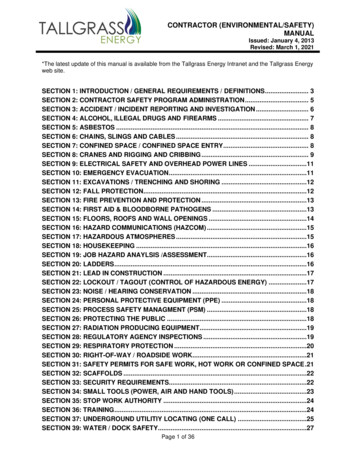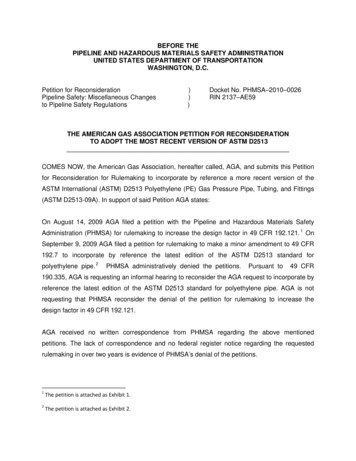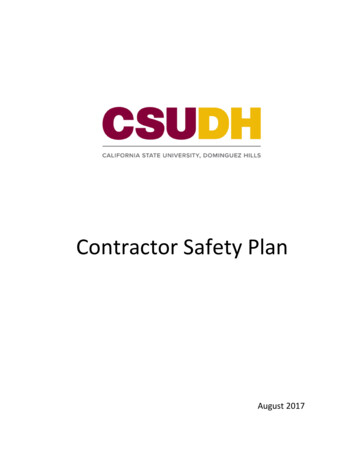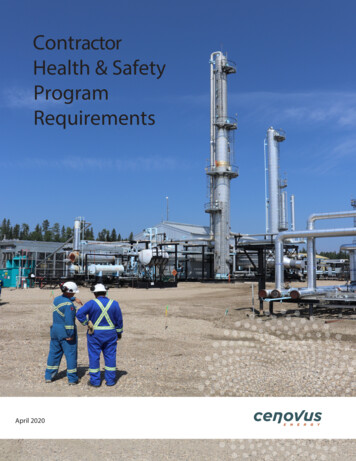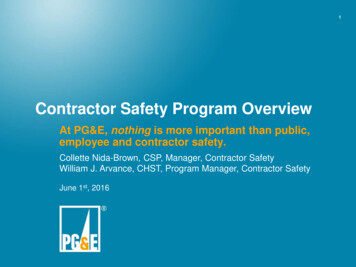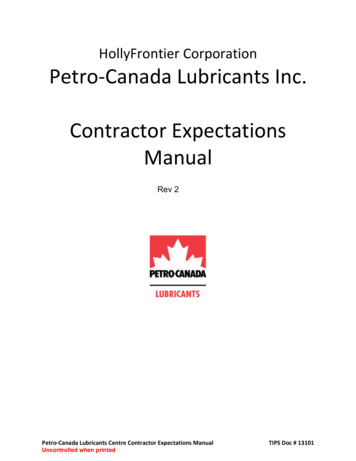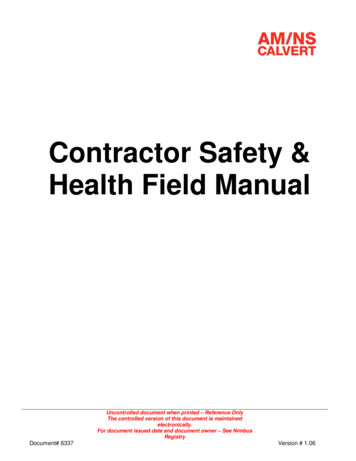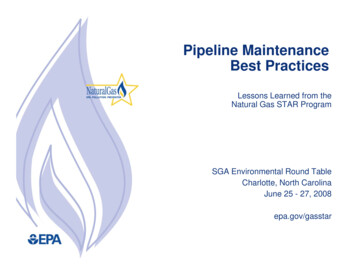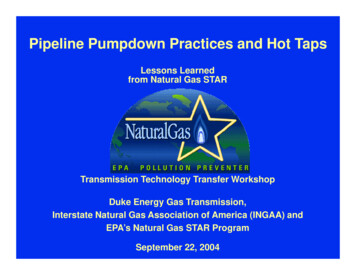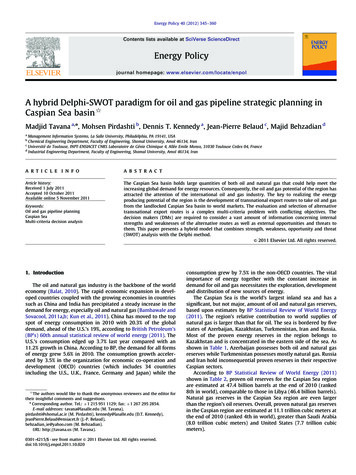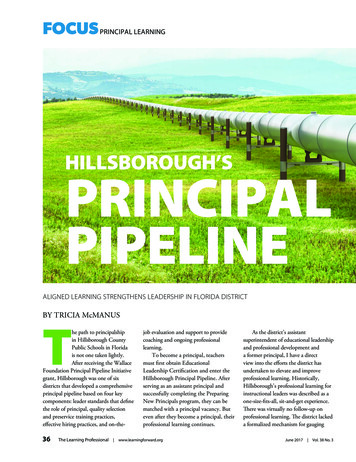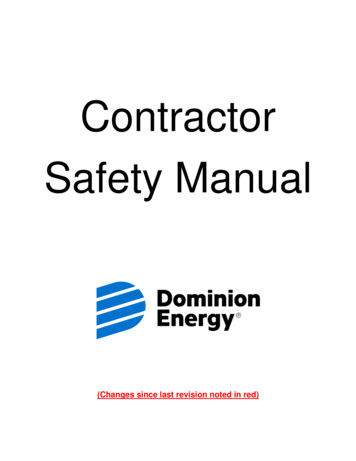
Transcription
ContractorSafety Manual(Changes since last revision noted in red)
Contractor Safety ManualPage 2 of 59Table of ContentsSection 1 – General RequirementsSection 2 – DefinitionsSection 3 – ComplianceSection 4 – Duty to InterveneSection 5 – Life Saving RulesSection 6 – General Safety RequirementsSection 7 – Incident Reporting and Investigation ProceduresSection 8 – Workplace Requirements81 – Professional Conduct8.2 – Use of Site8.3 – Firearms, Drugs and Alcohol8.4 – Drug and Alcohol Program (NON-DOT)8.5 – Smoking and Open Flame8.6 – Security8.7 – Adverse Weather Conditions8.8 – Cell Phone Use While Operating a Motor Vehicle8.9 – Access and Egress8.10 – Emergency ProceduresSection 9 – Safety Meetings9.1 – Daily Tailgate Meetings9.2 – Pre-job Meetings9.3 – Regularly Scheduled Safety MeetingsSection 10 – Process Safety ManagementSection 11 – Personal Protective Equipment11.1 – General11.2 – Eye Protection11.3 – Foot Protection11.4 – Hand Protection11.5 – Head Protection11.6 – Hearing Protection11.7 – Flame Retardant Clothing11.8 – Special Protective Clothing11.9 – Respiratory ProtectionSection 12 – Elevated Work12.1 – General12.2 – Fall Protection12.3 – Personnel Lifts and Aerial Lifts12.4 – Guard Rails and Barricading12.5 – Portable Ladders12.6 – ScaffoldingSection 13 – Motor Vehicle SafetySection 14 – Hazardous Material TransportationRev: 5Changes since last revision in Red. February 2019
Contractor Safety ManualPage 3 of 59Section 15 – Work Zone Traffic ControlSection 16 – Forklifts and BackhoesSection 17 – Trenching and ExcavationSection 18 – Overhead Utilities SafetySection 19 – Hazard Communication Program and Chemical Management RequirementsSection 20 – First Aid RequirementsSection 21 – Occupational Health and Industrial HygieneSection 22 – Hazardous Substances22.1 – Naturally Occurring Radioactive Material (NORM)22.2 – Lead22.3 – Pipe Wrap22.4 – Hydrogen Sulfide22.5 – Pipeline Liquids, Sludge and Powders22.6 – Contaminated Soils22.7 – Crystalline SilicaSection 23 – Electrical SafetySection 24 – Lockout / TagoutSection 25 – Confined Space EntrySection 26 – Fire PreventionSection 27 – Hot WorkSection 28 – Hot TappingSection 29 – WeldingSection 30 – Pressure Testing (Hydrostatic / Pneumatic)Section 31 – Steep Grade Pipeline InstallationsSection 32 – Compressed Gas CylindersSection 33 – Compressed Air Used For CleaningSection 34 – Slips, Trips, and FallsSection 35 – Hand and Power ToolsSection 36 – SandblastingSection 37 – PaintingSection 38 – Cranes and RiggingSection 39 – Drilling and Well Servicing OperationsSection 40 – Isolation and Purging of EquipmentSection 41 – Piping Systems at Well SitesSection 42 – Pressurized Production EquipmentSection 43 – Valves and EquipmentSection 44 – Electrical Storms During Seismic Drilling OperationsSection 45 - Application of Herbicides on Company Owned or Leased PropertySection 46 – Boring Procedure using Directional Drilling when Crossing Sewer LateralsSection 47 – Working Over, In or Near WaterRev: 5Changes since last revision in Red. February 2019
Contractor Safety Manual1.GENERAL REQUIREMENTS1.1.1.2.Rev: 5Page 4 of 59This Contractor Safety Manual (Manual) contains the minimum requirements you and yourcompany (Contractor) shall comply with while on property owned, operated, or under thecontrol of Dominion Energy’s western subsidiaries (collectively Company) includingDominion Energy Utah, Dominion Energy Wyoming, Dominion Energy Idaho, DominionEnergy Questar Pipeline, Wexpro, Wexpro II, Overthrust, Questar Southern Trails Pipeline,Questar Energy Services. It is intended to preserve the independent contractor relationshipwhile helping improve contractor health and safety performance. Contractor shall ensurethat any subcontractor it uses to perform Work (defined below) on behalf of Contractor forCompany meets or exceeds these same requirements. This Manual shall be attached toand incorporated in any agreement between Contractor and Company for Work performedfor Company and shall supplement Contractor’s own safety program. This Manual cannotaddress all health and safety on-the-job circumstances; therefore, it is Contractor’sresponsibility to evaluate the specific job hazards and the health and safety requirementsassociated with these activities and take any additional precautions necessary to preventharm to persons or damage to property or the environment appropriate for thecircumstances. Notwithstanding anything to the contrary in this Manual, any agreementbetween Contractor and Company, or Contractor’s own safety program, no safetyrequirement shall be less stringent than the minimum state and federal safety standards.Contractor shall be solely responsible for the safety of its employees, subcontractors, andagents in the performance of the Work. As a condition of doing business with Company,Contractor is expected to have developed and must maintain effective health and safetyprograms that include but are not limited to:1.2.1.Compliance with all applicable federal, state, tribal, and local laws, rules,regulations, and orders of governing authority bearing on health and safety topersons, property, or the environment and their protection from damage, injury,or loss;1.2.2.Be enrolled in ISNetworld, submit required safety and insurance documentation,and have an approved status with Company;1.2.3.On the first week of each month, Contractor shall enter the following informationinto ISNetworld:a. Hours worked for the Company for the previous month;b. The number of work-related injuries, illnesses and fatalities which occurredon a Company project for the previous month (enter “0” if no injuries,illnesses or fatalities occurred). Include a brief description of each incidentand include the location;c. The number of spills which occurred on a Company project for the previousmonth (enter “0” if no spills occurred). Include a brief description of each spillincident and include the location;1.2.4.Accountability for safety by management;1.2.5.Safety orientation and training for all workers, including new or inexperiencedworkers;1.2.6.Documentation of safety training and safety awareness efforts;1.2.7.Documented safety performance reporting and monitoring;1.2.8.Assigned safety support responsibilities;1.2.9.Incident investigation and reporting to determine cause;Changes since last revision in Red. February 2019
Contractor Safety ManualPage 5 of 2.7.2.8.2.9.Rev: 5Implementation and reinforcement of appropriate consequences to support thesafety program;1.2.11. As applicable, a written and enforced drug and alcohol policy that meets theDOT’s (defined below) requirements in Drug and Alcohol Testing, 49 CFR Part199 and Procedures for Transportation Workplace Drug and Alcohol TestingPrograms, 49 CFR Part 40, each as amended; and1.2.12. As applicable, a written and enforced Operator Qualification Program that meetsCompany-specific requirements and DOT’s requirements in 49 CFR Part 192,Subpart N, each as amended. (Note: certain affiliates of Company addadditional requirements beyond those required by DOT.)Nothing contained in this Manual is intended to relieve Contractor of its responsibility forsafety applicable to the Work performed for Company.The capitalized terms in this section shall have the meaning given them below. Capitalizedterms used elsewhere in this Manual shall have the meaning given them in that particularsection.“CFR” means the Code of Federal Regulations.“Company Property” means all property owned, operated, leased by, or under the control ofCompany, including rights-of-way and worksites."Competent Person" is defined as one who is capable of identifying existing and predictablehazards in the surroundings or working conditions that are unsanitary, hazardous, ordangerous to workers, property, or the environment, and who has the authorization to takeprompt corrective measures to eliminate them. By way of training and/or experience, acompetent person is knowledgeable of applicable standards, is capable of identifyingworkplace hazards relating to the specific operation, and has the authority to correct them.Some regulatory standards add additional specific requirements that shall be met byContractor’s competent person.“Confined Space” is a space that meets the following criteria:2.5.1.Is large enough and configured so that a worker can bodily enter and performassigned work inside;2.5.2.Has limited or restricted means for entry or exit (e.g., tanks, vessels); and2.5.3.Is not designed for continuous worker occupancy.“Contractor” means the person or entity hired by Company to perform Work for Company,whether on or off Company Property, including any and all employees, subcontractors,suppliers, agents, and representatives performing any portion of the Work on behalf ofContractor.“Dedicated Safety Representative” is a person assigned to a worksite whose soleresponsibility on that job is to ensure compliance with safety requirements in connectionwith performance of the Work. The safety representative shall be qualified to perform theWork by education (e.g., OSHA (defined below) 40-hour course, higher education in relatedfield), certification (e.g., CSP, CIH), or experience. This person shall have current certifiedfirst-aid/CPR training.“Designated Safety Representative” is a person assigned to a worksite that is responsiblefor safety, but may also have more than one role in connection with performance of theWork. This person shall have current certified first-aid/CPR training.“DOT” means the U.S. Department of Transportation, including its agencies.Changes since last revision in Red. February 2019
Contractor Safety .2.19.Rev: 5Page 6 of 59“Exposure Limit” means concentration limits of airborne contaminants established by OSHAtermed Permissible Exposure Levels (PELs) and the American Conference of IndustrialHygienists (ACGIH) termed Threshold Limit Values (TLVs); these levels represent theconcentration to which nearly all workers may be repeatedly exposed without experiencingadverse health effects.“Hazard” means a condition or inherent physical or chemical characteristic (flammability,toxicity, corrosivity, stored chemical, electrical, hydraulic, pressurized or mechanicalenergy) that has the potential for causing harm or damage to people, property, or theenvironment.“Hazardous Atmosphere” means an atmosphere that exposes workers to risk of death,incapacitation, injury, or acute illness from one or more of the following:2.12.1. A flammable gas, vapor, or mist in excess of 10 percent of its lower explosivelimit (LEL). In the case of natural gas, 10% LEL equals 0.5 % by volume.2.12.2. An airborne combustible dust in a concentration that obscures vision at adistance of 5 feet or less.2.12.3. An atmosphere with an oxygen deficient concentration below 19.5 percent oroxygen enriched concentration above 23.5 percent by volume.2.12.4. An atmospheric concentration of any substance that exceeds an Exposure Limitor other atmospheric condition that is IDLH.“Immediately Dangerous to Life or Health” (IDLH) means an atmosphere that poses animmediate threat to life, would cause irreversible adverse health effects, or would impair anindividual’s ability to escape from a dangerous atmosphere.“Industrial hygiene” is the science or art devoted to the anticipation, recognition, evaluation,and control of those environmental factors (stresses) arising in or from the workplace thatmay cause sickness, impaired health and wellbeing, or significant discomfort amongworkers or among the public.“Job Safety Analysis” (JSA) means a method used to identify, analyze, and record thefollowing:2.15.1. The steps involved in performing a specific job;2.15.2. The existing or potential safety and health hazards associated with each step;and2.15.3. The recommended actions or procedures to eliminate or reduce the hazards andthe risk of a workplace injury or illness.“Near miss” is an incident or situation with the potential for injury or property damage thatdid not occur.“OSHA” is the Occupational Safety and Health Administration.“Permit Required Confined Space” is a Confined Space that has one or more of thefollowing characteristics:2.18.1. Contains or has a potential to contain a Hazardous Atmosphere;2.18.2. Contains a material that has the potential for engulfing an entrant;2.18.3. Has an internal configuration such that an entrant could be trapped orasphyxiated by inwardly converging walls or by a floor that slopes downward andtapers to a smaller cross-section; or2.18.4. Contains any other recognized serious safety or health hazard.“Process Safety Management” (PSM) is the standard adopted by OSHA in Process SafetyManagement of Highly Hazardous Chemicals, 29 CFR §1910.119 that is applicable toChanges since last revision in Red. February 2019
Contractor Safety Manual2.20.2.21.3.contractors performing maintenance or repair, turnaround, major renovations, or specialtywork on or adjacent to a covered process. It only applies to facilities that meet the relevantdefinitions.“Underground Facility” means any piece of equipment or apparatus buried or placed belowground for use in connection with the storage or conveyance of water, sewage, electronic,telephonic, or other form of electronic communications, cable television, electric energy, oil,gas, hazardous liquids, or other substances and including, but not limited to, pipes, sewers,conduits, cables, valves, lines, wires, manholes, and attachments.“Work” means all services performed, and/or all supervision, labor, tools, equipment,machinery, materials, and supplies used or provided by Contractor, on behalf of Companypursuant to an agreement between Contractor and Company.COMPLIANCE3.1.3.2.3.3.3.4.3.5.Rev: 5Page 7 of 59Contractor shall have established written safety and health programs, at or before start ofany Work, to prevent injury, illness, damage, and minimize accidents and loss to the public,employees, workers, property, and the environment. The program shall continue to finalcompletion of the Work and conform to applicable laws, rules, regulations, and orders ofgoverning authority and generally accepted industry standards.Contractor and its subcontractors shall be evaluated by Company on their performance andWork practices, including but not limited to compliance with federal, state, and local healthand safety requirements as well as the requirements of this Manual. To verify compliance,Contractor may be subject to detailed safety and environmental audits, including site visits,attendance at Contractor’s safety meetings, and inspection of equipment, any time duringthe term of the working relationship with Company.3.2.1.Contractor shall cooperate fully with Company’s audits and inspections.3.2.2.Company shall document Contractor’s safe and at-risk safety performance.3.2.3.The evaluation results may be used in the decision process for awarding futureWork.3.2.4.If Contractor’s overall safety and/or environmental performance evaluation isunsatisfactory and Contractor is unwilling to demonstrate prompt and satisfactoryimprovement, Company may remove Contractor from the Work, as moreparticularly set forth in the agreement between Contractor and Company.3.2.5.Serious, willful, or repeated violations of safety requirements by Contractor maybe deemed a material breach of Contractor’s agreement and reason for contracttermination.Contractor shall enforce safety procedures, strict discipline, and good order amongContractor’s employees and subcontractors at any tier; fighting, horseplay, and otherunsafe behavior are prohibited. If Company reasonably determines that a particular persondoes not follow safety procedures, is unfit or unskilled for the assigned Work, disregardsinstructions, or jeopardizes the goodwill between Company and the public, Contractor shallimmediately replace the person upon receipt of Company’s request to do so and shall notemploy the person again on the Work.If a safety violation is observed by Company, Company shall discuss the violation withContractor’s representative on the job at the time of discovery. Contractor shall promptlyimplement corrective actions and establish measures to prevent a recurrence.If in Company’s sole discretion, the Work presents a condition that is unsafe or harmful topeople, property, or the environment, Company shall have the right to suspend the Work, inwhole or in part, until the condition is corrected or terminate the Work.Changes since last revision in Red. February 2019
Contractor Safety Manual3.6.3.7.4.4.2.4.3.4.4.No worker is expected to work in an unsafe environment or to perform an unsafe act, andno worker shall be penalized for refusing to do so.Anyone who observes an unsafe action or condition in the workplace has an obligation tointervene by taking one or all of the following actions to correct the condition or situation:4.2.1.Communicating concerns and asking questions;4.2.2.Notifying appropriate supervisors; and4.2.3.Shutting down the job, if necessary.Contractor shall ensure that all of its employees, subcontractors, agents, andrepresentatives performing any portion of the Work are informed of these “stop work”requirements.Never circumvent the stop work authority of another worker.Life Saving Rules5.1.Rev: 5Contractor shall inform Company immediately if Contractor is approached or contacted by aregulatory inspector at any time with respect to any aspect of the Work.Contractor shall immediately forward any citations or notices of violation incurred during theWork to Company’s representative.DUTY TO INTERVENE (STOP WORK)4.1.5.Page 8 of 59The Company values the safety of our customers, contractors, employees and the public,and believes that all injuries are preventable. Life Saving Rules focus on certain areas ofhigh risk and high consequence. All Company affiliates have adopted the Life Saving Rulesand expect all employees and Contractors to comply. Company may remove anyContractor from the workplace for intentionally violating a Life Saving Rule, which are listedbelow.5.1.1.Lockout / Tagouta. Never work on equipment without isolating all known hazardous energysources and verifying isolation.b. Never remove another worker’s lockout or tagout device without following thewritten procedures for abandoned lock/tag removal.5.1.2.Atmospheric Monitoringa. Never enter into a designated Confined Space or an underground pit or vaultwithout first conducting atmospheric testing.5.1.3.Stop Worka. Never circumvent the stop work authority of another employee or Contractor.5.1.4.Trench Safetya. Never enter an unsafe trench or a trench greater than 5 feet deep withoutproper protective systems in place.5.1.5.Fall Protectiona. Never work at an elevated position more than four (4) feet high without theuse of a proper fall protection system in place.5.1.6.Reporting Safety Incidentsa. Never intentionally provide false or incomplete information during a safetyrelated investigation.5.1.7.Blowing GasChanges since last revision in Red. February 2019
Contractor Safety Manual5.1.8.5.1.9.6.a. Never enter into an escaping gas atmosphere not regulated by valves,squeeze bars, tapping equipment or other mechanical measures withoutnotifying supervision, donning a flash fire suit and respiratory protection, andhaving the required additional employee(s).Texting or Emailing While Drivinga. Never engage in texting or emailing while driving on Company business.Seat Belt Usagea. All individuals must wear seat belts while driving or riding in any vehicle usedfor Company business, and while operating other motorized equipment wherea seat belt is provided.GENERAL SAFETY 10.Rev: 5Page 9 of 59Contractor shall have sufficient knowledge, experience, and understanding of natural gasworkplace safety and health hazards and other regulatory requirements pertaining to theWork to be performed.Contrac
Contractor Safety Manual Page 4 of 59 Rev: 5 Changes since last revision in Red. February 2019 1. GENERAL REQUIREMENTS 1.1. This Contractor Safety Manual (Manual) contains the minimum requirements you a
